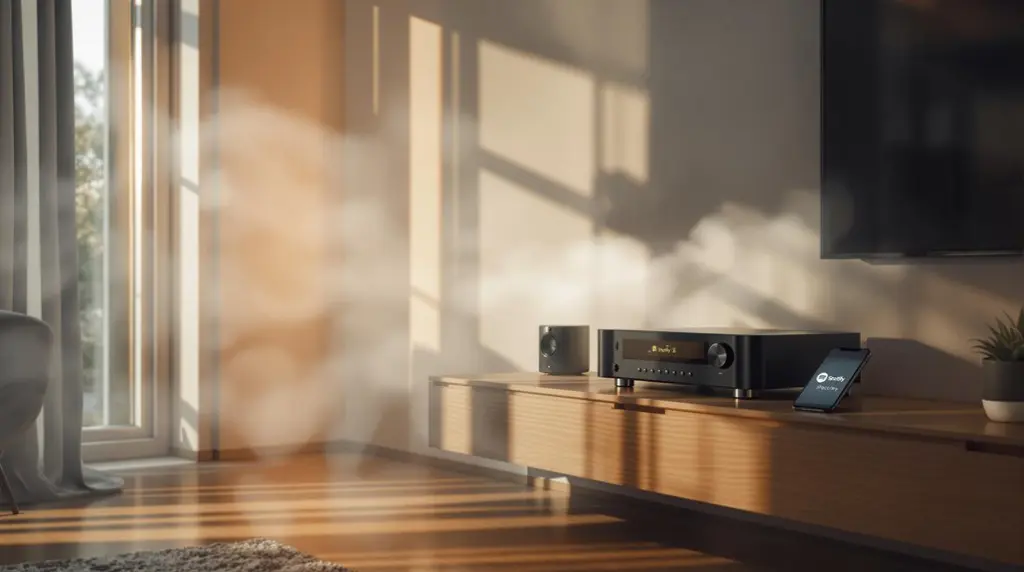Integrating external instruments such as synthesizers and drum machines into DJ sets boosts creativity and sound diversity. Achieving seamless sync is critical; use MIDI clock signals from DJ software like Traktor or Ableton for precise timing, and guarantee correct MIDI channel settings. Alternatively, manual sync methods, although requiring keen tempo perception, offer flexibility during live performances. Key elements include using high-pass filters for mix clarity and incorporating devices like the Roland TR-8S or Pioneer DJ DJS-1000 for robust rhythmic additions. Understand MIDI basics, proper connection setups, and synchronization techniques to enhance your sets further. Explore deeper insights for mastering these integrations effectively.
Key Takeaways
- Sync External Instruments: Use MIDI clock signals from DJ software like Traktor or Ableton for precise timing and synchronization.
- Manual Syncing: Match external drum machine BPM to DJ track manually for flexibility and control without complex setups.
- Live Performance Enhancement: Incorporate drum machines to add low-end presence and synthesizers for unique soundscapes.
- Recommended Gear: Consider drum machines like Roland TR-8S and Pioneer DJ DJS-1000 for superior sound and live performance capabilities.
- Troubleshooting Techniques: Restart MIDI clock and test compatibility with your mixer to resolve sync issues during live shows.
Syncing Techniques Overview
Syncing external instruments in DJ sets involves a variety of techniques that can greatly enhance performance dynamics. One primary method is using MIDI clock signals from DJ software such as Traktor or Ableton. By establishing correct MIDI connections and configuring software preferences, DJs can guarantee precise timing, mitigating timing challenges that often arise during live performances.
This synchronization allows drum machines and synthesizers to follow the tempo of the DJ set accurately, providing a seamless integration of external sounds. Additionally, MIDI mapping can be used to assign specific functions within Ableton to external controllers, increasing the level of control during a performance.
Another advanced method involves using mixers with MIDI output capabilities, such as the Pioneer DJM 800/900. These mixers can detect incoming audio beats and generate MIDI clock signals, coordinating the timing of connected instruments.
Although this setup can automatically sync devices, DJs must be cautious of tempo changes, as they can disrupt synchronization. In such cases, restarting the sync process may be necessary to maintain cohesion.
Manual Sync Method
The manual sync method requires the DJ to manually match the tempo of the external drum machine to the DJ track, often using integer BPM values like 123 for ease of synchronization.
This technique offers quick setup and flexibility, enabling seamless live performance without the complexity of MIDI integration.
Fine-tuning adjustments via the drum machine’s tempo knob allow for precise control, although the DJ must manually correct any tempo changes in the track.
Matching Track Tempo
Mastering the manual sync method is essential for DJs aiming to flawlessly incorporate external drum machines into their sets. This technique requires precise tempo matching techniques, ensuring that the drum machine’s tempo aligns seamlessly with the track’s tempo. Typically, both devices are set to whole values, such as 123 BPM, to facilitate easier adjustments and maintain consistent performance dynamics.
| Aspect | Details |
|---|---|
| Initial Setup | Set both track and drum machine to the same BPM (e.g., 123 BPM) |
| Key Advantage | Quick setup without the need for MIDI cables or complex configurations |
| Performance Requirement | Manual adjustments needed for any tempo changes during the performance |
This method is advantageous for its simplicity and speed, bypassing the need for MIDI cables or intricate setups. However, one must be vigilant, as the drum machine does not automatically adapt to tempo changes within the track. This necessitates real-time manual adjustments using the drum machine’s tempo knob, maintaining alignment and ensuring a cohesive sound.
Despite its limitations, the manual sync method considerably boosts performance dynamics, allowing DJs to integrate drum patterns and live elements seamlessly. By honing these tempo matching techniques, DJs can enhance their sets, achieving a more engaging and dynamic performance.
Fine-Tuning Tempo Adjustments
Employing the manual sync method, DJs can achieve precise tempo alignment by meticulously fine-tuning the drum machine’s tempo knob during live performances. This approach requires acute tempo perception, as DJs manually match the drum machine’s tempo to the track’s BPM, often set to whole values like 123 BPM for easier adjustments.
The manual sync method is particularly advantageous for spontaneous setups, as it eliminates the need for MIDI cables and allows for immediate synchronization.
Fine-tuning the drum machine’s tempo knob guarantees the beat remains aligned, granting DJs the rhythmic flexibility needed to maintain the energy and flow of their set.
However, a notable limitation of this method is that the drum machine does not automatically follow any tempo changes made to the track during the performance. Consequently, DJs must be adept at quick adjustments to preserve the sync.
- Immediate Setup: No need for MIDI cables, making it ideal for impromptu performances.
- Enhanced Control: Manual synchronization practice hones DJs’ ability to control tempo and maintain set energy.
- Rhythmic Flexibility: Allows for dynamic adjustments, guaranteeing the beat remains consistent despite tempo changes.
Mastering the manual sync method enhances a DJ’s overall skill set, fostering a deeper understanding of tempo perception and rhythmic control.
Using a Mixer With MIDI
Integrating a mixer with MIDI capabilities into your DJ setup can greatly enhance your performance by enabling seamless synchronization with external instruments. Mixers like the Pioneer DJM 800/900 offer MIDI integration, allowing automatic beat detection and synchronization with devices such as drum machines.
This MIDI output streamlines the process of aligning your beats, thereby facilitating performance enhancement. Additionally, using mixers with advanced beatgrid precision guarantees accurate alignment of beats, vital for seamless mixing.
To sync a drum machine using a MIDI-capable mixer, connect the MIDI out from the mixer to the MIDI in of the drum machine using a MIDI cable. This setup guarantees that your external instruments stay in time with your DJ set.
However, be aware that the auto-detection of incoming audio beats, while simplifying synchronization, can sometimes falter with tempo changes. In such cases, a restart might be required to resync the devices.
For peak control, manual tempo adjustments are advised over relying solely on automatic beat detection. This approach not only provides greater flexibility but also prevents potential synchronization issues.
It is important to note that compatibility with MIDI clock synchronization can vary by mixer model. As a result, testing different setups is essential for verifying peak performance and connectivity with your external instruments.
Syncing With DJ Software
Syncing your DJ software with external instruments requires precise MIDI clock configuration to guarantee seamless integration.
Begin by connecting the MIDI out from your DJ controller to the MIDI in on your drum machine, and configure both devices to the same MIDI channel.
Fine-tune sync alignment by adjusting the MIDI clock transmission settings in your DJ software and applying Offset adjustments if necessary.
MIDI Clock Configuration
To achieve seamless integration of external instruments such as drum machines with DJ software, enabling the MIDI clock within the software preferences is vital. This configuration allows the software to send clock signals to connected external devices, guaranteeing synchronized timing.
Proper setup involves connecting the MIDI output from your DJ controller or software to the MIDI input of the drum machine using a standard MIDI cable. Both devices must be set to the same MIDI channel to facilitate proper communication, minimizing sync latency and enhancing overall performance.
Adjusting the MIDI Clock Offset settings in your DJ software is important for fine-tuning synchronization. Even minor timing adjustments can greatly improve performance tightness.
Additionally, restarting the MIDI clock during a live set can resolve sync issues, guaranteeing continuous and accurate timing.
Utilizing advanced DJ software like Ableton Live or Traktor can streamline this process, as these platforms support sending MIDI clock signals to external devices.
- Enable MIDI Clock: Activate the MIDI clock in the software preferences.
- Proper Connections: Use a MIDI cable to connect the DJ controller/software to the external instrument.
- Sync Adjustments: Fine-tune MIDI Clock Offset settings for ideal synchronization.
This meticulous setup is fundamental for a cohesive and dynamic DJ performance.
Sync Adjustment Techniques
Achieving precise synchronization between DJ software and external instruments necessitates meticulous attention to sync adjustment techniques. Using DJ software such as Traktor and Ableton, MIDI clock signals can be dispatched to external drum machines and synthesizers for tight beat alignment.
To facilitate this, users must connect the MIDI out port of their controller to the MIDI in port of the external instrument and configure the MIDI clock settings within the software preferences.
One significant sync adjustment technique involves MIDI delay compensation. This entails fine-tuning the Sending Offset settings to guarantee the external instruments harmonize perfectly with the DJ software’s tempo. Proper offset adjustments can mitigate latency issues, assuring that beats and rhythms are flawlessly synchronized.
Performance troubleshooting is essential if sync issues arise during a live set. A common remedy is restarting the MIDI clock, which can re-establish synchronization between the devices. This quick fix often resolves timing discrepancies and restores seamless integration.
Effective sync adjustment techniques not only enhance the technical performance but also enrich the auditory experience. By integrating drum machines and synths with precision, DJs can uplift their live sets, delivering dynamic and engaging performances that captivate audiences.
Live Set Applications
Incorporating external instruments such as drum machines and synthesizers into DJ sets greatly boosts live performance capabilities, allowing DJs to craft dynamic loops and live sequences that captivate audiences. Effective live performance strategies involve leveraging these tools to fill sonic gaps, particularly in tracks lacking low-end presence.
Drum machines are pivotal in this situation, as they provide heavier kicks and intricate percussion patterns, essential for driving genres like techno and house. Additionally, using high-pass filters can further improve the clarity of the mix by eliminating unnecessary low-frequency clutter, especially when integrating external instruments.
Synthesizers, on the other hand, enable DJs to create unique soundscapes and textures. This real-time remixing and creative manipulation not only enriches the set but also employs audience engagement techniques by offering a novel auditory experience with each performance.
The integration of these instruments guarantees an immersive and cohesive sound, achieved through the precise alignment of tempo using MIDI sync.
Notable examples, such as Ean Golden’s CNTRL tour, demonstrate how the effective use of drum machines and synths can enhance DJ sets:
- Enhanced low-end presence: Drum machines add depth and drive.
- Creative soundscapes: Synthesizers offer unique textures and real-time remixing.
- Seamless shifts: MIDI sync maintains tempo alignment for a cohesive performance.
These elements collectively illustrate the transformative potential of incorporating external instruments in live DJ sets.
MIDI Basics and Setup
Mastering MIDI basics and setup is vital for DJs aiming to seamlessly integrate external instruments into their performances. MIDI (Musical Instrument Digital Interface) supports up to 16 MIDI channels, enabling intricate communication between devices like drum machines and synths. Properly configuring each device to the correct MIDI channel guarantees effective communication, which is foundational for synchronized performance.
In addition, DJs can utilize real-time beat matching tools available in many DJ software platforms to enhance synchronization with MIDI instruments.
To maintain signal integrity, selecting appropriate cable types is essential. Traditional 5-pin MIDI cables are standard, but Ethernet cables may be used for specific devices, offering enhanced stability. Confirming that all devices are connected via the proper cabling reduces the risk of signal degradation.
Latency issues are a common challenge in live settings. Understanding the differences between software and hardware MIDI monitoring types can mitigate these issues. Hardware monitoring typically provides lower latency, improving real-time performance synchronization.
Activating the MIDI button on mixers, such as those in the Pioneer DJM series, is necessary for the successful operation of external instruments. Moreover, MIDI sync capabilities allow DJ software or DAWs to send clock signals, guaranteeing all devices play in perfect time.
This cohesion is vital for a seamless, professional DJ set.
Recommended Drum Machines
Selecting the right drum machine is essential for DJs aiming to enhance their live sets with dynamic rhythms and beats. The market offers a variety of options, each boasting unique features tailored to different performance needs. For beginners, integrating built-in effects and intuitive controls helps streamline the learning process.
The Roland TR-8S stands out for its superior sound quality and innovative features like the nudge function, ensuring precise beat matching and a seamless integration into any DJ set. Its intuitive interface and extensive sound library make it a versatile tool for both live performances and studio work.
The Pioneer DJ DJS-1000 is designed specifically for live DJ performances, offering real-time sampling capabilities and a user-friendly interface. This drum machine allows DJs to seamlessly incorporate drum sounds on-the-fly, enhancing the spontaneity and creativity of their sets.
For those who prioritize simplicity, the Arturia DrumBrute Impact offers a straightforward interface combined with a robust sound engine. Its ease of use makes it an ideal choice for DJs who want to quickly and effectively add rhythmic elements without a steep learning curve.
- Akai MPC One: Combines drum machine functionality with powerful sampling and sequencing capabilities.
- Korg Volca Beats: Offers classic analog sounds and MIDI compatibility at an affordable price.
- Roland TR-8S: Features high-quality sounds and precise beat matching with its nudge function.
Frequently Asked Questions
How to Connect Drum Machine to DJ Mixer?
To connect a drum machine to a DJ mixer, utilize a MIDI cable for midi synchronization and 1/4-inch TRS cables for audio routing. Ascertain both devices share the same MIDI channel and consult the mixer’s manual for specific configurations.
Can You DJ With a Synth?
Yes, synth integration into DJ setups allows for enhanced live performance. By incorporating hardware synths, DJs can add live melodic elements and unique sounds, creating a dynamic and interactive experience that transcends standard pre-recorded mixes.
Do DJS Use Drum Machines?
Yes, DJs frequently use drum machines, such as the Roland TR-8, SP-16, and Pioneer DJ DJS-1000, to enhance live performances. These drum machine types provide dynamic loops and percussion, enriching the overall sound and audience engagement.
How Do You Connect DJ Instruments?
To connect DJ instruments, guarantee proper MIDI connectivity and audio routing. Utilize MIDI cables and a compatible mixer for synchronization, and configure your DJ software to enable MIDI clock transmission. Routinely test connections to maintain consistent performance.
Conclusion
Incorporating external instruments such as synths and drum machines into DJ sets necessitates a thorough understanding of syncing techniques, manual synchronization, and MIDI integration. Utilizing a mixer with MIDI capabilities or DJ software can enhance the seamless blending of live and pre-recorded elements. Mastery of MIDI basics is essential for ideal setup and performance. By leveraging recommended drum machines and applying these methodologies, DJs can notably raise the dynamic range and complexity of their sets.




